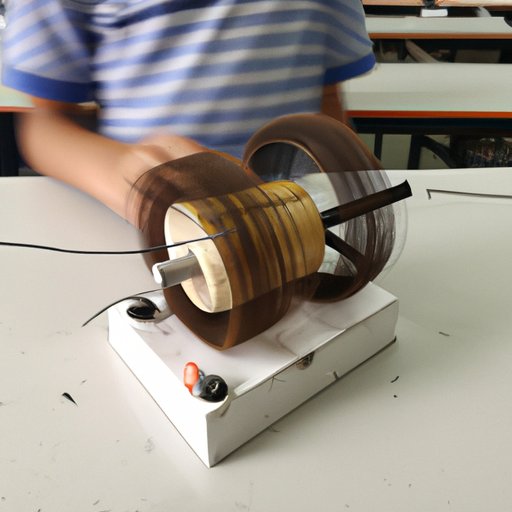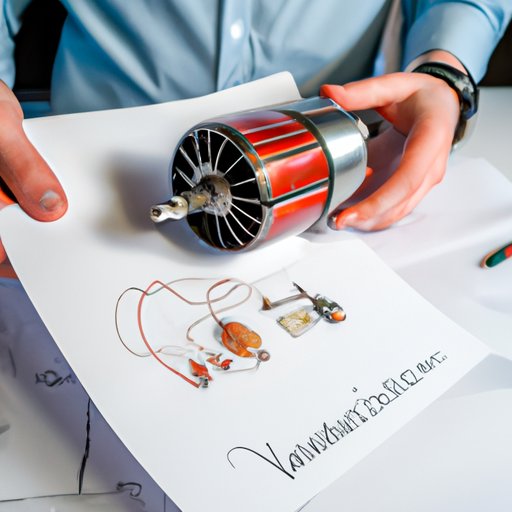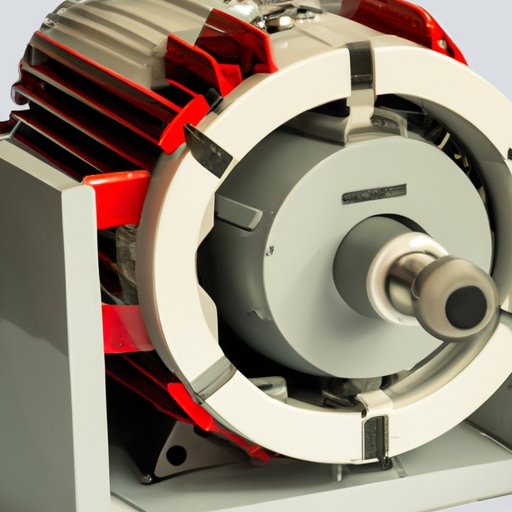Introduction
An electric motor is a device that converts electrical energy into mechanical energy. It works by using electricity to create a magnetic field which then causes the motor to move or rotate. The electric motor is one of the most versatile pieces of machinery and can be found in all sorts of devices from cars to vacuum cleaners, fans, and even robots.
In this article, we will explore how does an electric motor work, with a step-by-step guide to understanding the basics, a closer look at its components and mechanics, an examination of the different types of electric motors and their functions, and finally, an analysis of the benefits of using an electric motor in various applications.
Step-by-Step Guide to Understanding the Basics of an Electric Motor
Electric motors are made up of several basic components that must interact with each other in order to produce motion. These components include a rotor, stator, armature, commutator, and field magnet.
The rotor is a part of the electric motor that rotates when a current is applied to it. The stator is the stationary part of the electric motor that provides a magnetic field for the rotor to react against. The armature is the part of the electric motor that is connected to the rotor and is responsible for converting electrical energy into mechanical energy. The commutator is the part of the electric motor that helps to keep the rotor spinning in the correct direction. Finally, the field magnet is the part of the electric motor that creates a magnetic field in order to cause the rotor to spin.
Now that we have looked at the components of an electric motor, let’s take a look at the process of how it works. When an electric current is applied to the armature of the electric motor, it creates a magnetic field. This magnetic field interacts with the magnetic field generated by the stator, causing the rotor to move or rotate. As the rotor spins, it produces mechanical energy which can then be used to power a variety of devices.

Exploring the Physics Behind How an Electric Motor Works
At the core of how an electric motor works is the principle of electromagnetic induction. Electromagnetic induction is the process of generating an electric current in a conductor by exposing it to a changing magnetic field. This process was first described by scientist Michael Faraday in 1831.
The process of electromagnetic induction works by creating a magnetic field around a coil of wire. When a current is applied to the coil, it creates a magnetic field which causes the electrons in the coil to move. This movement of electrons creates an electric current in the coil which then interacts with the magnetic field, causing the coil to move or rotate.
The conservation of energy also plays an important role in how an electric motor works. In order for the electric motor to produce mechanical energy, it must draw energy from an external source such as a battery or power grid. This energy is then converted into mechanical energy which can be used to power a variety of devices.
Finally, Faraday’s law of electromagnetic induction states that the magnitude of the induced electromotive force (EMF) in a closed circuit is equal to the rate of change of the magnetic flux through the circuit. In other words, the strength of the magnetic field created by the electric motor is directly proportional to the amount of current applied to it.
A Closer Look at the Components and Mechanics of an Electric Motor
Now that we have explored the physics behind how an electric motor works, let’s take a closer look at the components and mechanics of an electric motor. As mentioned earlier, the electric motor is composed of several basic components including a rotor, stator, armature, commutator, and field magnet.
The rotor is the part of the electric motor that rotates when a current is applied to it. The stator is the stationary part of the electric motor that provides a magnetic field for the rotor to react against. The armature is the part of the electric motor that is connected to the rotor and is responsible for converting electrical energy into mechanical energy.
The commutator is the part of the electric motor that helps to keep the rotor spinning in the correct direction. Finally, the field magnet is the part of the electric motor that creates a magnetic field in order to cause the rotor to spin.

Examining the Different Types of Electric Motors and Their Functions
There are several different types of electric motors, each of which has its own unique features and functions. Some of the most common types of electric motors include induction motors, synchronous motors, brushless DC motors, and stepper motors.
Induction motors are the most commonly used type of electric motor and are used in a wide variety of applications such as HVAC systems, pumps, and compressors. Synchronous motors are used in applications where precise speed control is required such as in clocks, robotics, and medical equipment. Brushless DC motors are used in applications where high efficiency and low noise levels are desired such as in electric vehicles and computer cooling fans. Finally, stepper motors are used in applications where accurate positioning is required such as in 3D printers and CNC machines.

Analyzing the Benefits of Using an Electric Motor in Various Applications
Electric motors offer many advantages over traditional combustion engines. One of the primary benefits of using an electric motor is its efficiency. Electric motors are more efficient than combustion engines because they convert more of the energy input into usable output.
Another benefit of using an electric motor is the low cost of operation. Electric motors require less maintenance than combustion engines and can run for long periods of time without needing to be serviced. Additionally, electric motors are much quieter than combustion engines and can be used in a variety of applications without disrupting the environment.
Finally, electric motors offer a high power output compared to other types of motors. This makes them ideal for applications that require a lot of power such as industrial machinery and robotics.
Conclusion
In conclusion, electric motors are incredibly versatile pieces of machinery that can be used in a variety of applications. They are composed of several components which work together to convert electrical energy into mechanical energy. The process of how an electric motor works is based on the principles of electromagnetic induction and the conservation of energy. There are several different types of electric motors, each of which has its own unique features and functions. Finally, electric motors offer many advantages over traditional combustion engines including greater efficiency, lower cost of operation, durability, and high power output.
Electric motors are an integral part of our modern world and continue to play an important role in a variety of applications. With advances in technology, electric motors are becoming increasingly efficient and powerful, allowing us to use them in new and exciting ways.
(Note: Is this article not meeting your expectations? Do you have knowledge or insights to share? Unlock new opportunities and expand your reach by joining our authors team. Click Registration to join us and share your expertise with our readers.)
